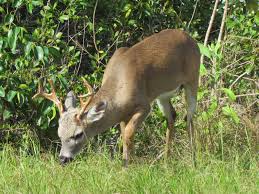IT’S YOUR ENVIRONMENT
Off the beaten path: Sprawling Deer Refuge protects numerous species
KONK LIFE COLUMNIST
I went for a walk in the woods today, through a slash pine forest on No Name Key. The trail led me past marshlands to a large man-made lake where I held a one-sided conversation with a small alligator. On my way, I saw a cardinal, numerous turkey vultures that watched me carefully, and at least eight Key deer.
The deer were no surprise, as the area I walked in was part of the National Key Deer Wildlife Refuge, and as a former resident of Big Pine Key, I know how brazen these little beggars can be. But some might be surprised at the diversity that can be found in this area, aside from the endangered Key Deer.
The National Key Deer Refuge encompasses more than 8,000 acres on 25 islands. It is home to 22 endangered animals and crucial Keys habitats including pine rockland forests, tropical hardwood hammocks, freshwater wetlands and salt marsh wetlands. The refuge is critical habitat for hundreds of species, 17 of which are endemic to the Keys.
Just a few of the rare animals in this area include the Lower Keys marsh rabbit, the silver rice rat, rare frogs and turtles, according to Park Ranger Kristie Killam, who works at the Florida Keys Refuges Complex. Killam says time and patience and a willingness to follow the refuge’s numerous foot trails are all that is needed to see plentiful wildlife.
Key Deer (Odocoileus virginianus clavium) are an endangered subspecies of the White-tailed deer.
As adorable and approachable as the deer might be, Killam reminds you not to feed them.
“If we could eat candy and cookies and ice cream every day, we would, too.”
Intern Lauren Breza, who works at the refuge, added that the deer are not starving. They can find hundreds of plant species they love to eat that grow naturally here, such as red mangroves.
Feeding the deer is what makes them unafraid of humans. Killam said that about 150 Key Deer were killed by cars in 2014. When I pulled my car off the road on No Name Key, the deer crossed the road to greet me.
The Key Deer story began as long as 20,000 year ago, when white-tailed deer roamed from Virginia to Florida with the waters much lower around the Florida Peninsula. As the Wisconsin Glacier began to melt, the sea level rose and trapped some of the deer that had migrated south. As the land area diminished, so did the food. The Key Deer out of necessity adapted to survive on less food and water and became a smaller species (about 55-80 pounds).
The first written record of the Key Deer was in 1575 by a Spaniard held captive by Keys Indians. Ship logs from this century collaborate the deer’s existence.
During the early 20th Century, new residents in the Keys hunted the deer to near extinction.
An editorial cartoon by Ding Darling sparked national interest in the plight of the Key Deer. Ding Darling was a Pulitzer Prize-winning cartoonist and a key player in the early conservation movement of this nation. The cartoon, which called them “Toy Deer,” led to the state legislature banning hunting them in 1939.
Hunting continued, however, and the deer population had dropped to about 25 by the mid-1940s.
In 1947, 11- year-old Glenn Allen from Miami organized Boy Scouts and others in a letter-writing campaign that led to the establishment of National Key Deer Refuge in 1957, according to an Endangered Species Bulletin published by the U.S. Fish and Wildlife.
Killam said there are now between 800-1,000 deer living on Big Pine Key. The deer now range from Sugarloaf Key to Bahia Honda State Park.
“The Key deer are a success story,” she said.
“When you protect an area for a species like the Key deer, you protect it for everybody.”
She said the refuge shelters hundreds and possibly thousands of different species.
A bright and colorful visitor center for The National Key Deer Refuge and the Lower Keys Refuge Complex tucked away in the back corner the Big Pine Key Plaza. Friendly volunteers like Bob Mundro and Carol Houserman love to answer questions from visitors.
The refuge offers regular guided walks, bike rides, film series and moonlight kayak trips, among numerous other activities.
For regular updates, search on Facebook for Florida Keys National Wildlife Refuges Complex or call the refuge at 305-872-2239.
You will find a lot more than key deer if you take the time to explore any random trail on Big Pine Key or No Name Key.
“You just have to get off the beaten trail,” Killam said.
[livemarket market_name="KONK Life LiveMarket" limit=3 category=“” show_signup=0 show_more=0]







Love the Key Deer! Love the Reserve set aside for them and the other animals!
BUT – is the 45/35 mile per hour, along with ALL THE SIGNS REALLY NECESSARY? We have spent millions fencing (with a fence 10 times taller than the deer) and creating a way for the few on the ONE little island to cross under the roadway. When is enough a enough?
Just saying? Couldn’t all the tax dollars spent maintaining that one mile stretch of roadway be better spent on other projects?